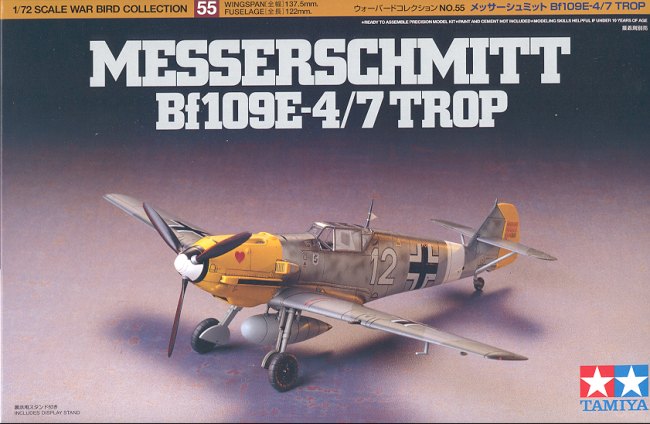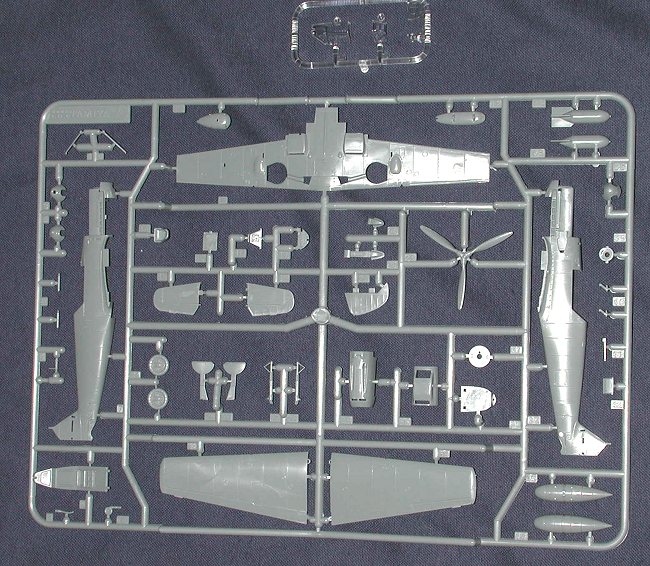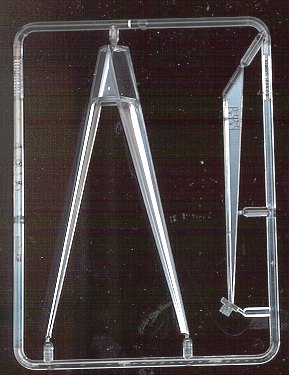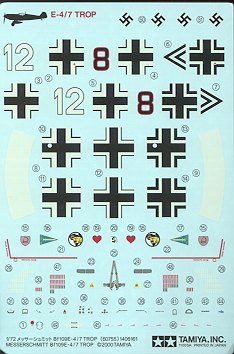
|
KIT: |
Tamiya 1/72 Bf-109E-4 |
|
KIT # |
60755 |
|
PRICE: |
$16.50 |
|
DECALS: |
Three aircraft: see review |
|
REVIEW & |
|
|
NOTES: |

|
HISTORY |
The Bf-109E-4 was introduced in time to see service during the Battle of Britain. It took care of some of the shortcomings of the earlier version, such as the addition of a flat paneled windscreen and canopy, and additional pilot armor plating. What was not changed was the short range of the type. During the Battle, the 109s were left with insufficient fuel to properly do battle with the Hurricanes and Spitfires of the RAF. Often times the cover of Bf-109s would have to return to base in France and leave the bombers at the mercy of the defending fighters.
It was with the E-7 that this discrepancy was somewhat alleviated. This was done by attaching an auxiliary fuel tank of 300 liters to the bomb rack that was part of the E-4 upgrade. This modification was also added to many of the remaining E-4 subtypes. However it was too late to really do any good in the Battle of Britain as bomber losses had been so high as to have had the attack called off as Hitler planned his assault against the Soviet Union. Part of the E-4 update was also a version designed to operate in the hot, dry, desert locale of Northern Africa. This 'trop' or tropical modification was most easily seen from the outside by the addition of a sand filter covering the supercharger intake. Other improvements included a survival kit in the tail section in case the aircraft was forced to land in the desert.
|
THE KIT |

 If you are
thinking that the sprues look very much like those of the Bf-109E-3 that was
previewed earlier, then you are correct! In fact, the only plastic difference to
the two kits is the clear bits, with the E-4/7 kit having the proper
canopy/windscreen for the subtype. There was also something else in this kit
that I have not seen in a kit from a major model maker in a long, long, time.
That is a stand! It suspiciously looks like those stands offered in Tamiya's
1/100 series of kits, though this one is molded in clear plastic. There is no
hole in the fuselage to cut out so if you want to use it, you need to make that
surgical incision yourself. It is also a bit odd as there is no pilot figure
offered, but it is there to use if you want to.
If you are
thinking that the sprues look very much like those of the Bf-109E-3 that was
previewed earlier, then you are correct! In fact, the only plastic difference to
the two kits is the clear bits, with the E-4/7 kit having the proper
canopy/windscreen for the subtype. There was also something else in this kit
that I have not seen in a kit from a major model maker in a long, long, time.
That is a stand! It suspiciously looks like those stands offered in Tamiya's
1/100 series of kits, though this one is molded in clear plastic. There is no
hole in the fuselage to cut out so if you want to use it, you need to make that
surgical incision yourself. It is also a bit odd as there is no pilot figure
offered, but it is there to use if you want to.
The instructions are everything that one has come to expect from the premier model maker. It is easy to understand, follows logical construction steps and offers the proper color readouts in with the construction steps. It also continues to refer the builder to Tamiya paints and requires the modeler to mix colors for standard RLM shades. No RLM reference numbers are given at all. I'd hope that by now Tamiya would have started doing this, but it is obvious that they see no need to.
 Decals are
provided for three aircraft, all of which have been seen in other kits before,
so nothing new there. First is a yellow nosed white 12 from 7./JG 26 in RLM
74/75 over RLM 76. Next is a 2./JG 27 in desert camouflage of tan with green
blotches over medium blue undersides. It could be in RLM desert shades, or
just as easily in Italian colors. Finally, in RLM 71/02 over RLM 65 is an
aircraft flown by Maj. Helmut Wick. Decals are typically thick and the lighter
colors appear to be a bit transparent, but they should work quite well.
Decals are
provided for three aircraft, all of which have been seen in other kits before,
so nothing new there. First is a yellow nosed white 12 from 7./JG 26 in RLM
74/75 over RLM 76. Next is a 2./JG 27 in desert camouflage of tan with green
blotches over medium blue undersides. It could be in RLM desert shades, or
just as easily in Italian colors. Finally, in RLM 71/02 over RLM 65 is an
aircraft flown by Maj. Helmut Wick. Decals are typically thick and the lighter
colors appear to be a bit transparent, but they should work quite well.
I can tell you that this is a superb kit and is highly recommended to all skill levels.
|
REFERENCES |
German Aircraft of the Second World War, by JR Smith & Anthony Kay, Putnam, 1972.
Review kit courtesy of me and my wallet!
If you would like your product reviewed fairly and quickly by a site that averages over 2,200 visits a day, please contact me or see other details in the Note to Contributors.